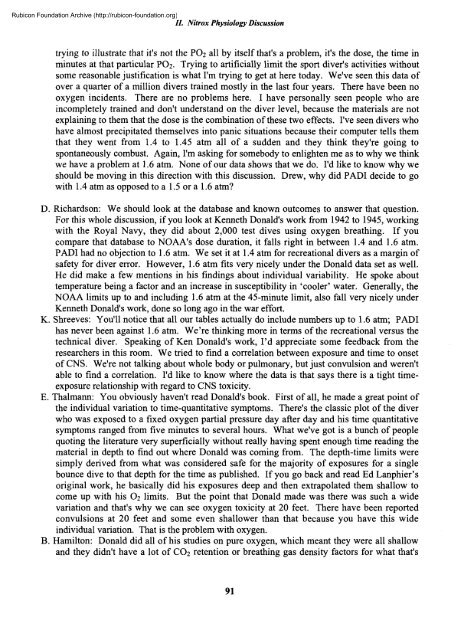Nitrox workshop dings - Divers Alert Network
Nitrox workshop dings - Divers Alert Network
Nitrox workshop dings - Divers Alert Network
Create successful ePaper yourself
Turn your PDF publications into a flip-book with our unique Google optimized e-Paper software.
Rubicon Foundation Archive (http://rubicon-foundation.org)//. <strong>Nitrox</strong> Physiology Discussiontrying to illustrate that it's not the PO2 all by itself that's a problem, it's the dose, the time inminutes at that particular PO2. Trying to artificially limit the sport diver's activities withoutsome reasonable justification is what I'm trying to get at here today. We've seen this data ofover a quarter of a million divers trained mostly in the last four years. There have been nooxygen incidents. There are no problems here. I have personally seen people who areincompletely trained and don't understand on the diver level, because the materials are notexplaining to them that the dose is the combination of these two effects. I've seen divers whohave almost precipitated themselves into panic situations because their computer tells themthat they went from 1.4 to 1.45 atm all of a sudden and they think they're going tospontaneously combust. Again, I'm asking for somebody to enlighten me as to why we thinkwe have a problem at 1.6 atm. None of our data shows that we do. I'd like to know why weshould be moving in this direction with this discussion. Drew, why did PADI decide to gowith 1.4 atm as opposed to a 1.5 or a 1.6 atm?D. Richardson: We should look at the database and known outcomes to answer that question.For this whole discussion, if you look at Kenneth Donald's work from 1942 to 1945, workingwith the Royal Navy, they did about 2,000 test dives using oxygen breathing. If youcompare that database to NOAA's dose duration, it falls right in between 1.4 and 1.6 atm.PADI had no objection to 1.6 atm. We set it at 1.4 atm for recreational divers as a margin ofsafety for diver error. However, 1.6 atm fits very nicely under the Donald data set as well.He did make a few mentions in his fin<strong>dings</strong> about individual variability. He spoke abouttemperature being a factor and an increase in susceptibility in 'cooler' water. Generally, theNOAA limits up to and including 1.6 atm at the 45-minute limit, also fall very nicely underKenneth Donald's work, done so long ago in the war effort.K. Shreeves: You'll notice that all our tables actually do include numbers up to 1.6 atm; PADIhas never been against 1.6 atm. We're thinking more in terms of the recreational versus thetechnical diver. Speaking of Ken Donald's work, I'd appreciate some feedback from theresearchers in this room. We tried to find a correlation between exposure and time to onsetof CNS. We're not talking about whole body or pulmonary, but just convulsion and weren'table to find a correlation. I'd like to know where the data is that says there is a tight timeexposurerelationship with regard to CNS toxicity.E. Thalmann: You obviously haven't read Donald's book. First of all, he made a great point ofthe individual variation to time-quantitative symptoms. There's the classic plot of the diverwho was exposed to a fixed oxygen partial pressure day after day and his time quantitativesymptoms ranged from five minutes to several hours. What we've got is a bunch of peoplequoting the literature very superficially without really having spent enough time reading thematerial in depth to find out where Donald was coming from. The depth-time limits weresimply derived from what was considered safe for the majority of exposures for a singlebounce dive to that depth for the time as published. If you go back and read Ed Lanphier'soriginal work, he basically did his exposures deep and then extrapolated them shallow tocome up with his O2 limits. But the point that Donald made was there was such a widevariation and that's why we can see oxygen toxicity at 20 feet. There have been reportedconvulsions at 20 feet and some even shallower than that because you have this wideindividual variation. That is the problem with oxygen.B. Hamilton: Donald did all of his studies on pure oxygen, which meant they were all shallowand they didn't have a lot of CO2 retention or breathing gas density factors for what that's91
















